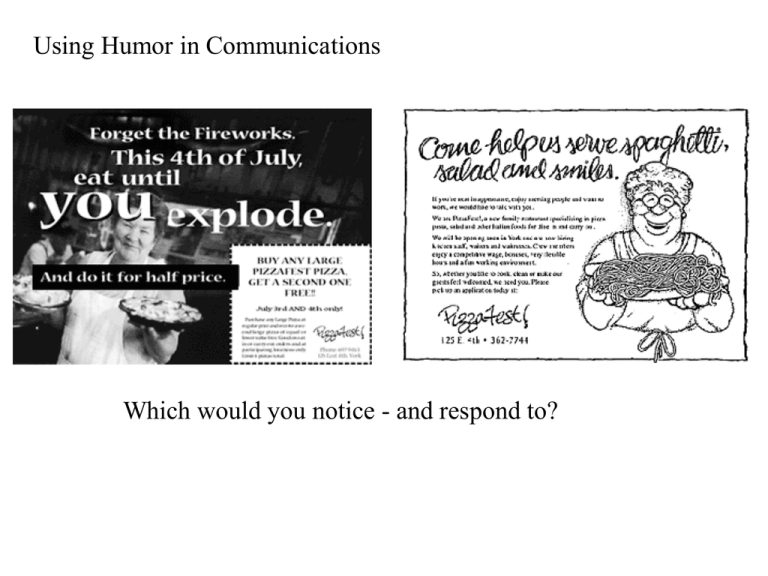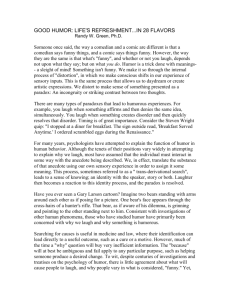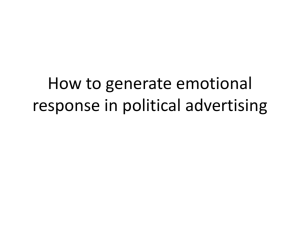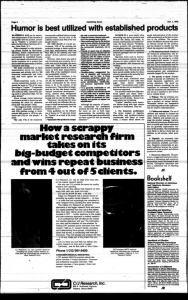Mark Levit is managing partner of Partners & Levit Advertising and a
advertisement

Using Humor in Communications Which would you notice - and respond to? Many of the most memorable ad campaigns around tend to be funny. Advertisers use this strategy to attract customers to their product. Audiences like to be entertained, but not pitched. People will pay more attention to a humorous commercial than a factual or serious one, opening themselves up to be influenced. The key to funny advertising is assuring the humor is appropriate to both product and customer. The balance between funny and obnoxious can often be delicate; and a marketer must be certain the positive effects outweigh the negative before an advertisement can be introduced. The best products to sell using humor tend to be those that consumers have to think the least about. Products that are relatively inexpensive, and often consumable, can be represented without providing a lot of facts, and that’s where there’s room for humor. Candy, food, alcohol, tobacco and toys/entertainment related products have proven to benefit the most from humor in their campaigns. One of the most important things to keep in mind is relevance to the product. An example of an extremely successful humorous campaign is the series of “Yo Quiero Taco Bell” commercials. The star, a tiny talking Chihuahua who is passionate about his Taco Bell got people repeating the company’s name across the country. The repetition of the company name and the actual content of the commercial reinforce the message in a relevant manner. Taco Bell saw a substantial rise in sales and their own mascot became a pop icon. Another point to consider when using humor in advertising is that different things are funny to different people. A commercial that may leave one person gripping their sides from laughter may leave a bad taste in another’s mouth. The target market must always be considered. What’s funny in a client presentation may not be funny on an airplane, at a country club or in a hospital. Humor in advertising tends to improve brand recognition, but does not improve product recall, message credibility, or buying intentions. In other words, consumers may be familiar with and have good feelings towards the product, but their purchasing decisions will probably not be affected. One of the major keys to a successful humorous campaign is variety, once a commercial starts to wear out there’s no saving it without some variation on the concept. Humorous campaigns are often expensive because they have to be constantly changed. Advertisers must remember that while making the customer laugh, they have to keep things interesting, because old jokes die along with their products. Mark Levit is managing partner of Partners & Levit Advertising and a professor of marketing at New York University. Partners & Levit's clients include Procter & Gamble, UnitedHealth Group, and GE Commercial Finance. Ad campaign uses humor to fight colon cancer January 30, 2002 Posted: 11:33 AM EST (1633 GMT) Polyp Man is the new villain in public service announcements encouraging colon cancer screening. By Elizabeth Cohen and Miriam Falco CNN Medical Unit NEW YORK (CNN) -- It's a bird. It's a plane. No, it's Polyp Man, and he's no superhero. He's the villain in a series of public service announcements being sent out to television stations this week. Dressed in red tights and a bulbous red suit, Polyp Man runs from doctors in scenes reminiscent of "Cops" or "NYPD Blue." "He's hilarious," said Dr. Harmon Eyre, chief medical officer for the American Cancer Society, which is sponsoring the PSAs together with the Advertising Council. "I like the one where he's in a woman's kitchen with his face smeared with food and the doctors come and chase him down." The point of the ads is to persuade people to get tested for colon cancer. The tag line for the ad is "Get the test, get the polyp, get the cure." Everyone over age 50 is supposed to get tested, but only about 44 percent actually do, according to the cancer society. The society estimates that half of all colon cancer deaths could be prevented if everyone got screening. Even when polyps are benign they can turn into the perfect breeding ground for colon cancer. The voice-over in the ads says, "Colon cancer almost always starts with a polyp. Get the polyp early and stop colon cancer before it even starts." The comedic approach to a health issue is a dramatic departure from tradition. For example, in 1990, the American Cancer Society ran PSA's showing graveyard scenes to make their point, but the ads didn't work, Eyre said. He says he hopes things will be different with Polyp Man. "We've done focus groups by the dozens and people find it motivational," Eyre said. "They get the message and recognize it's colon cancer and are supposed to go to their doctor and get a test." In the ads, Polyp Man tries to escape from doctors in scenes reminiscent of the TV show 'Cops'. He said only about 10 percent of the focus group members objected to the ads for making light of a serious subject. At the moment, Geico's market share is 5.6 percent—far below that of the big boys like State Farm (18.2 percent) and Allstate (10.4 percent). But Geico is growing fast, and it relies on direct-toconsumer sales (through a Web site or 800 number) instead of a network of salesguy middlemen. While its competitors are running lots of dour ads that exploit our fear of accidents, Geico stands out from the clutter with its oddball humor and lighthearted tone. The company has managed to inject fun into a product that we resent having to buy and that we associate with miserable moments. That's no mean feat. You never stop driving a BMW Word Play One in a million Last but not least One thing after another Non smoking pub Try to figure out the phone number… Funeral home services billboard ad Are there rules to using humor in direct marketing? Is there life after death? You decide, but consider the following 10 dos and don'ts as guidelines: 1. Don't over-analyze a humorous idea. It's funny, or it's not. As Mark Twain said, "Trying to figure out why something is funny is like dissecting a frog. You'll come up with answers, but the frog always dies.“ 2. Don't use humor for its own sake. Make it relevant to your objective. 3. Don't use humor to deceive or tell a lie. It's a scientific fact that humor intensifies positive physical and psychological reactions; deceit will undermine these good feelings and supplant them with anger and resentment. 4. Do use humor to entertain. People love to be entertained. (What do you do in your free time?) 5. Do use humor to be thought-provoking, but not offensive. 6. Do test humorous concepts, not techniques. Slapstick, irony and word play are techniques, but what is the idea you want to convey? 7. Do let your reader/listener/viewer experience the joy of "getting it." You'll make a friend. 8. Do engage the imagination of your customers. Theirs may be even bigger than yours. 9. Do the homework on your customer, and I don't necessarily mean formal research. A renowned copywriter from the early days of advertising called research "putting on my hat and going out to talk to people." Humor comes from knowing your audience inside-out. 10. Don't forget that rules are meant to be broken. The best humor comes from the edge, where there are no rules.






